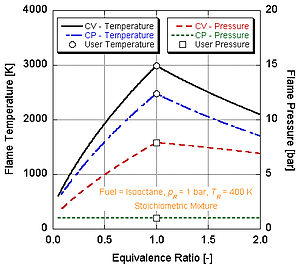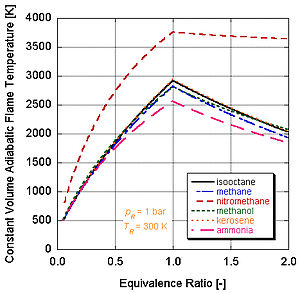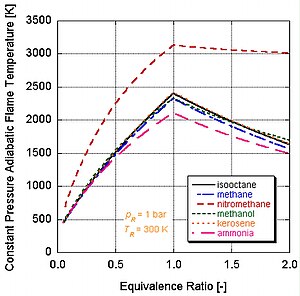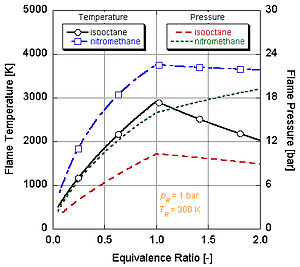Adiabatic flame temperature

In the study of combustion, the adiabatic flame temperature is the temperature reached by a flame under ideal conditions. It is an upper bound of the temperature that is reached in actual processes.
There are two types adiabatic flame temperature: constant volume and constant pressure, depending on how the process is completed. The constant volume adiabatic flame temperature is the temperature that results from a complete combustion process that occurs without any work, heat transfer or changes in kinetic or potential energy. Its temperature is higher than in the constant pressure process because no energy is utilized to change the volume of the system (i.e., generate work).
Common flames


In daily life, the vast majority of flames one encounters are those caused by rapid oxidation of hydrocarbons in materials such as wood, wax, fat, plastics, propane, and gasoline. The constant-pressure adiabatic flame temperature of such substances in air is in a relatively narrow range around 1950 °C. This is mostly because the heat of combustion of these compounds is roughly proportional to the amount of oxygen consumed, which proportionally increases the amount of air that has to be heated, so the effect of a larger heat of combustion on the flame temperature is offset. Incomplete reaction at higher temperature further curtails the effect of a larger heat of combustion.
Because most combustion processes that happen naturally occur in the open air, there is nothing that confines the gas to a particular volume like the cylinder in an engine. As a result, these substances will burn at a constant pressure, which allows the gas to expand during the process.
Common flame temperatures
Assuming initial atmospheric conditions (1 bar and 20 °C), the following table[1] lists the flame temperature for various fuels under constant pressure conditions. The temperatures mentioned here are for a stoichiometric fuel-oxidizer mixture (i.e. equivalence ratio φ = 1).
Note that these are theoretical, not actual, flame temperatures produced by a flame that loses no heat. The closest will be the hottest part of a flame, where the combustion reaction is most efficient. This also assumes complete combustion (e.g. perfectly balanced, non-smoky, usually bluish flame). Several values in the table significantly disagree with the literature[1] or predictions by online calculators.
| Fuel | Oxidizer 1 bar 20 °C |
||
|---|---|---|---|
| (°C) | (°F) | ||
| Acetylene (C2H2) | Air | 2,500 | 4,532 |
| Oxygen | 3,480 | 6,296 | |
| Butane (C4H10) | Air | 2,231 | 4,074[2] |
| Cyanogen (C2N2) | Oxygen | 4,525 | 8,177 |
| Dicyanoacetylene (C4N2) | Oxygen | 4,990 | 9,010 |
| Ethane (C2H6) | Air | 1,955 | 3,551 |
| Ethanol (C2H5OH) | Air | 2,082 | 3,779[3] |
| Gasoline | Air | 2,138 | 3,880[3] |
| Hydrogen (H2) | Air | 2,254 | 4,089[3] |
| Magnesium (Mg) | Air | 1,982 | 3,600[4] |
| Methane (CH4) | Air | 1,963 | 3,565[5] |
| Methanol (CH3OH) | Air | 1,949 | 3,540[5] |
| Naphtha | Air | 2,533 | 4,591[2] |
| Natural gas | Air | 1,960 | 3,562[6] |
| Pentane (C5H12) | Air | 1,977 | 3,591[5] |
| Propane (C3H8) | Air | 1,980 | 3,596[7] |
| Methylacetylene (CH3CCH) |
Air | 2,010 | 3,650 |
| Oxygen | 2,927 | 5,301 | |
| Toluene (C7H8) | Air | 2,071 | 3,760[5] |
| Wood | Air | 1,980 | 3,596 |
| Kerosene | Air | 2,093[8] | 3,801 |
| Light fuel oil | Air | 2,104[8] | 3,820 |
| Medium fuel oil | Air | 2,101[8] | 3,815 |
| Heavy fuel oil | Air | 2,102[8] | 3,817 |
| Bituminous coal | Air | 2,172[8] | 3,943 |
| Anthracite | Air | 2,180[8] | 3,957 |
| Oxygen | ≈3,500[9] | ≈6,332 | |
| Aluminium | Oxygen | 3,732 | 6,750[5] |
| Lithium | Oxygen | 2,438 | 4,420[5] |
| Phosphorus (white) | Oxygen | 2,969 | 5,376[5] |
| Zirconium | Oxygen | 4,005 | 7,241[5] |
Thermodynamics

From the first law of thermodynamics for a closed reacting system we have
where, and are the heat and work transferred from the system to the surroundings during the process, respectively, and and are the internal energy of the reactants and products, respectively. In the constant volume adiabatic flame temperature case, the volume of the system is held constant and hence there is no work occurring:
There is also no heat transfer because the process is defined to be adiabatic: . As a result, the internal energy of the products is equal to the internal energy of the reactants: . Because this is a closed system, the mass of the products and reactants is constant and the first law can be written on a mass basis,
- .

In the case of the constant pressure adiabatic flame temperature, the pressure of the system is held constant, which results in the following equation for the work:
Again there is no heat transfer occurring because the process is defined to be adiabatic: . From the first law, we find that,
Recalling the definition of enthalpy we obtain . Because this is a closed system, the mass of the products and reactants is the same and the first law can be written on a mass basis:
- .
We see that the adiabatic flame temperature of the constant pressure process is lower than that of the constant volume process. This is because some of the energy released during combustion goes, as work, into changing the volume of the control system.


If we make the assumption that combustion goes to completion (i.e. forming only CO
2 and H
2O), we can calculate the adiabatic flame temperature by hand either at stoichiometric conditions or lean of stoichiometry (excess air). This is because there are enough variables and molar equations to balance the left and right hand sides,
Rich of stoichiometry there are not enough variables because combustion cannot go to completion with at least CO and H
2 needed for the molar balance (these are the most common products of incomplete combustion),
However, if we include the water gas shift reaction,
and use the equilibrium constant for this reaction, we will have enough variables to complete the calculation.
Different fuels with different levels of energy and molar constituents will have different adiabatic flame temperatures.


We can see by the following figure why nitromethane (CH3NO2) is often used as a power boost for cars. Since each molecule of nitromethane contains an oxidant with relatively high-energy bonds between nitrogen and oxygen, it can burn much hotter than hydrocarbons or oxygen-containing methanol. This is analogous to adding pure oxygen, which also raises the adiabatic flame temperature. This in turn allows it to build up more pressure during a constant volume process. The higher the pressure, the more force upon the piston creating more work and more power in the engine. It stays relatively hot rich of stoichiometry because it contains its own oxidant. However, continual running of an engine on nitromethane will eventually melt the piston and/or cylinder because of this higher temperature.

In real world applications, complete combustion does not typically occur. Chemistry dictates that dissociation and kinetics will change the composition of the products. There are a number of programs available that can calculate the adiabatic flame temperature taking into account dissociation through equilibrium constants (Stanjan, NASA CEA, AFTP). The following figure illustrates that the effects of dissociation tend to lower the adiabatic flame temperature. This result can be explained through Le Chatelier's principle.
See also
References
- ^ a b See under "Tables" in the external references below.
- ^ a b Libal, Angela (27 April 2018). "What Temperatures Do Lighters Burn At?". Leaf Group Ltd. / Leaf Group Media. Sciencing.
- ^ a b c Flame Temperature Analysis and NOx Emissions for Different Fuels
- ^ "How hot does magnesium burn? | Reference.com". Archived from the original on 2017-09-17. Retrieved 2017-09-17.
- ^ a b c d e f g h CRC Handbook of Chemistry and Physics, 96th Edition, p. 15-51
- ^ "North American Combustion Handbook, Volume 1, 3rd edition, North American Mfg Co., 1986". Archived from the original on 2011-07-16. Retrieved 2009-12-09.
- ^ "Archived copy" (PDF). Archived from the original (PDF) on 2015-09-24. Retrieved 2013-05-19.
{{cite web}}: CS1 maint: archived copy as title (link) - ^ a b c d e f Power Point Presentation: Flame Temperature Archived 2011-07-17 at the Wayback Machine, Hsin Chu, Department of Environmental Engineering, National Cheng Kung University, Taiwan
- ^ Analysis of oxy-fuel combustion power cycle utilizing a pressurized coal combustor by Jongsup Hong et al., MIT, which cites IPCC Special Report on Carbon Dioxide Capture and Storage (PDF). Intergovernmental Panel on Climate Change. 2005. p. 122.. But the IPCC report actually gives a much less precise statement: "The direct combustion of fuel and oxygen has been practised for many years in the metallurgical and glass industries where burners operate at near stoichiometric conditions with flame temperatures of up to 3500°C." The temperature may depend on pressure, because at lower pressure there will be more dissociation of the combustion products, implying a lower adiabatic temperature.
External links
General information
- Babrauskas, Vytenis (2006-02-25). "Temperatures in flames and fires". Fire Science and Technology Inc. Archived from the original on 12 January 2008. Retrieved 2008-01-27.
- Computation of adiabatic flame temperature
- Adiabatic flame temperature
Tables
- "Adiabatic Flame Temperature". The Engineering Toolbox. Archived from the original on 28 January 2008. Retrieved 2008-01-27. adiabatic flame temperature of hydrogen, methane, propane and octane with oxygen or air as oxidizers
- "Flame Temperatures for some Common Gases". The Engineering Toolbox. Archived from the original on 7 January 2008. Retrieved 2008-01-27.
- Temperature of a blue flame and common materials
Calculators
- Online adiabatic flame temperature calculator using Cantera
- Adiabatic flame temperature program
- Gaseq, program for performing chemical equilibrium calculations.
- Flame Temperature Calculator - Constant pressure bipropellant adiabatic combustion
- Adiabatic Flame Temperature calculator

















